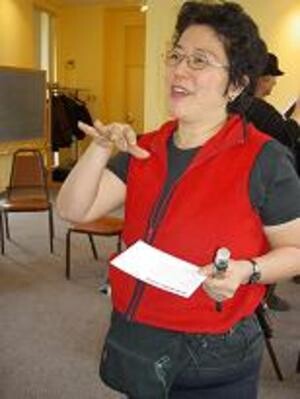hankyoreh
Links to other country sites 다른 나라 사이트 링크
[Memoir] Experiences of a Peace Study tour through South Korea

By JT Takagi, filmmaker at Third World Newsreel
I recently traveled through South Korea with some 50 scholars, artists and filmmakers on a Peace Study tour, titled “Korean War: Past and Present”, a first time collaboration between the Alliance of Scholars Concerned about Korea (ASCK.org) from the U.S., the Human Rights Foundation Saram, the Institute for Korean Historical Studies, the People’s Solidarity for Participatory Democracy, and the May 18th Memorial Foundation, with the April 9th Unification and Peace Foundation. In particular, the Human Rights Foundation Saram Director Park Lae-kun, and Professor Kim Dong-choon and Mr. Yi Tae-ho of PSPD worked to make this all possible. ASCK the group I am affiliated with, helps scholars, students, policy-makers and others learn about Korea through accurate analyses, and has just completed a 3 year Teaching initiative to End the Korean War, to foster dialogue and engagement to help bring about the signing of a Peace treaty. The ASCK organizing team included Professors Henry Em, Suzy Kim and Jae Jung Suh.
This on-site Peace Study tour examined long hidden tragedies and war crimes - as well as the current legacies of the unended Korean War. Organized because 2013 is the 60th anniversary of the signing of the Armistice, the tour aimed to focus attention on finally ending the Korean War, and bringing peace to Korea.
I’m a Japanese American filmmaker, who works with groups like the National Campaign to End the Korean War, which helps to build support for a Korean Peace treaty. With Third World Newsreel, co-producer Hye-Jung Park and others, I have made several films about the ongoing impact of the Korean War and the U.S. role in Korea, so I was eager to be part of this Peace Study tour.
On the tour, we went from the DMZ to Pyeongtaek, to the Nogun-ri and Geochang massacre sites, Guangju – and of course, Jeju Island and Gangjeong village, and learned a great deal, both factually and emotionally.
The Peace Study Tour ended with a trip to Jeju because it is so clearly part of the past and present of the national division and the ongoing Korean War – from the April 3rd Uprising and massacre to the current struggle to stop the construction of the naval base. As we all know, while the base is being built by the South Korean Navy, it’s clearly meant for use by the U.S., and its construction not only devastates a unique and beautiful ecosystem and way of life, but will contribute to increased military tensions and danger for all. As people from the U.S, it was our responsibility to witness and then act upon it on our return to the states.
Just as important, one of the reasons we wanted to be in Jeju at the end of our trip was also the inspiration and example that the Gangjeong villagers have provided to the rest of us. Despite the lengthy struggle, the painful and often demoralizing battles that the villagers have had to endure, the villagers still continue their efforts. As well, the incredibly kind and gracious hosting of our tour participants during our visit was a testament to their strength of heart.
My sense is that this Peace Study Tour – which I hope will continue in the future - inspired many of the tour participants. What we learned, as well as our interactions with our speakers, hosts and each other will enhance the work all of us are doing in the interests of truth, justice, reconciliation, democracy, and peace on the Korean peninsula.
The views presented in this column are the writer’s own and do not necessarily reflect those of the Hankyoreh.
Please direct questions or comments to [english@hani.co.kr]
Editorial・opinion
![[Column] Season 2 of special prosecutor probe may be coming to Korea soon [Column] Season 2 of special prosecutor probe may be coming to Korea soon](https://flexible.img.hani.co.kr/flexible/normal/500/300/imgdb/original/2024/0426/3317141030699447.jpg) [Column] Season 2 of special prosecutor probe may be coming to Korea soon
[Column] Season 2 of special prosecutor probe may be coming to Korea soon![[Column] Park Geun-hye déjà vu in Yoon Suk-yeol [Column] Park Geun-hye déjà vu in Yoon Suk-yeol](https://flexible.img.hani.co.kr/flexible/normal/500/300/imgdb/original/2024/0424/651713945113788.jpg) [Column] Park Geun-hye déjà vu in Yoon Suk-yeol
[Column] Park Geun-hye déjà vu in Yoon Suk-yeol- [Editorial] New weight of N. Korea’s nuclear threats makes dialogue all the more urgent
- [Guest essay] The real reason Korea’s new right wants to dub Rhee a founding father
- [Column] ‘Choson’: Is it time we start referring to N. Korea in its own terms?
- [Editorial] Japan’s rewriting of history with Korea has gone too far
- [Column] The president’s questionable capacity for dialogue
- [Column] Are chaebol firms just pizza pies for families to divvy up as they please?
- [Column] Has Korea, too, crossed the Rubicon on China?
- [Correspondent’s column] In Japan’s alliance with US, echoes of its past alliances with UK
Most viewed articles
- 1‘We must say no’: Seoul defense chief on Korean, USFK involvement in hypothetical Taiwan crisis
- 2After election rout, Yoon’s left with 3 choices for dealing with the opposition
- 3Why Kim Jong-un is scrapping the term ‘Day of the Sun’ and toning down fanfare for predecessors
- 4AI is catching up with humans at a ‘shocking’ rate
- 5Two factors that’ll decide if Korea’s economy keeps on its upward trend
- 6[Column] Park Geun-hye déjà vu in Yoon Suk-yeol
- 7Division commander ordered troops to enter raging flood waters before Marine died, survivor says
- 8Gangnam murderer says he killed “because women have always ignored me”
- 9South Korea officially an aged society just 17 years after becoming aging society
- 10No good, very bad game for Korea puts it out of Olympics for first time since 1988